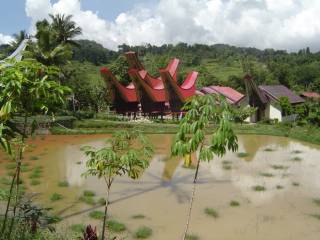"There is a belief in Toraja that when you die you won't be separated directly from the family - you are expected to bring them good luck and so the family must respect you. When we think of our ancestors, we respect them as individuals, rather than as a group".
"When a small baby dies, one who hasn't grown teeth yet, they used to be buried in a tree. It had to be a living tree, so that as the tree grew it continued the baby's life".
Nicolaus Pasassung, Sa'dan, Rantepao, Toraja
The Toraja live in stunningly beautiful houses in the mountainous southern region of the Indonesian island of Sulawesi. Their houses look like boats redesigned to sit on land.
Although mainly of Christian faith, many elements of the traditional religion, aluk to dolo ('the law of the ancestors') are still followed, especially in rural areas.




from Toraja Photo Gallery
In particular, they have unique death rituals.
“Spirits of the dead can be harmful or protective depending on how they died. People who died an unnatural death, such as through suicide, accidents or in childbirth, will not go easily to puya, the land of the dead. Ancestors must be treated with appropriate esteem or they will become unhappy, impoverished spirits”.
“The most important ceremony in a person's life cycle is the funeral. For this reason, there is often a lengthy interval between a person's death and their burial. Time is needed to ensure that all family members can attend and to save money to buy buffalo. In some cases, the deceased may be kept in the house for years, injected with formalin and placed in a temporary wooden coffin. In the past, the body would be laid on a mat in a special room, with bamboo pipes under the floor to catch and divert body fluids”.

Row of funeral houses on the rante, Toraja region, from Australian Museum Online
“Death is a gradual process rather than an abrupt event. The deceased is referred to as to mamma (sleeping person) or to masaki (sick person) until the commencement of funeral rites when they are called to membali puang (person who has become one of the gods) or to mate (dead person)”.
“The funeral is conducted on the rante (funeral ground) on which temporary structures are built to house the mourners and corpse”.

Tau tau gallery at the entrance of a burial site, near Rantepao, from Australian Museum Online
“Wooden human figures called
tau tauaccompany the deceased on their journey from the funeral house to the burial ground, where they watch over both the living and the dead. Once carved only for wealthy families, they are now status symbols used by a range of families”.
“Prior to the 17th century, Torajans were buried in elaborate, boat-shaped wooden coffins stored at the base of cliffs. After heirlooms were extensively plundered, Torajans began burying their dead in high cliff-face vaults. It is now common for people to be buried in family vaults”.

Toraja burial site near Londa, South Sulawesi, from Australian Museum Archives
Related Post: |
Social Bookmarking
4 comments:
I took a Death & Dying course and college. It is amazing the differences in cultures and how they treat death.
I think that to remember the good is sometimes the best.
To respect the dead is always right,
Kyle
I ask myself how many of these customs are still observed now that the Toraja people are mainly Christians?
In any case it is for them to decide for themselves.
Thanks for your comment and featuring my blog in yours. It is much appreciated!
Im a torajan from sulawesi and to be honest with you...this website is made up of bullshit. Everything you have read on this page is a load of rubbish. My people are very offended by this.
Dear Anonymous,
This post was based mainly on from material from "Australia Museum Online". I am sorry that you have been offended! I would gladly withdraw this post if you can be more specific about the inaccuracies and point out better sources of information. I would love to have an email address for me to inquire further.
If this piece is bullshit, I am keen to replace it with something better.
Sorry again.
Post a Comment